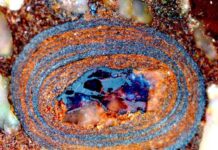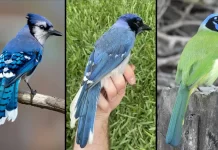Substance that gives birds mysterious power to see Earth’s magnetic field discovered by researchers.
New study has taken a step further towards understanding how birds detect the magnetic field of the Earth and use it to determine directions over short and long distances. Researchers at Sweden’s Lund University studying zebrafinches believe that a protein called Cry4, produced in the birds’ eyes, is the key.
A wide variety of creatures can detect and use the Earth’s magnetic field to navigate. For several types of invertebrates, amphibians, birds and some mammals, this magnetic compass has been shown to be dependent on light.
Despite extensive research, however, the sensory mechanisms involved in avian magnetoreception are still not fully understood.
In the case of birds, the receptors that sense the Earth’s magnetic field are probably located in their eyes.
The Swedish researchers were examining proteins in the eyes of zebrafinches when they discovered that one of them differs from the others: only the cryptochrome Cry4 protein maintains a constant level throughout the day and in different lighting conditions.
Their report, published this week in the Journal of the Royal Society Interface, says they “now know which of the birds’ cryptochromes do what”.
Cryptochromes are found in plants and animals. They play a role in in circadian rhythms, but have also been considered significant in the sensing of magnetic fields.
The researchers measured gene expression of Cry1, Cry2 and Cry4 in the retina, muscle and brain of the zebrafinches over the day to assess whether they exhibited signs of circadian rhythm.
They were working on the hypothesis that retinal cryptochromes involved in magnetoreception should be expressed at a constant level because birds use a light-dependent magnetic compass for orientation not only during migration, but also daily for spatial awareness.
Cryptochromes serving in circadian tasks, on the other hand, are expected to be expressed in a rhythmic (circadian) pattern.
Cry1 and Cry2 displayed a daily variation in the retina as expected for circadian clock genes, but Cry4 was expressed at constant levels over time.
As a result, the researchers conclude that Cry4 is the most likely candidate to be the magnetoreceptor of the light-dependent magnetic compass in birds. This specific protein helps the magnetic sense to function, while other cryptochromes, whose levels in the body vary at different times of the day, take care of the biological clock instead.
“Cry4 is an ideal magnetoreceptor as the level of the protein in the eyes is constant,” says Atticus Pinzon-Rodríguez, one of the researchers behind the study. “This is something we expect from a receptor that is used regardless of the time of day.”
In a 2017 study, Pinzon-Rodríguez and his colleagues noted that even resident birds that do not migrate have a magnetic sense and use it to navigate. “This and last year’s results indicate that other animals, perhaps all of them, have magnetic receptors and can pick up on magnetic fields,” he says.
A lot of research remains to map in detail how animals discover and use the Earth’s magnetic field. What is clear is that it involves chemical reactions that interact with magnetic fields. According to Pinzon-Rodríguez, this information could come into play in the development of new navigation systems.















